How To Fish Lake Berryessa
Lake Berryessa Fishing Report
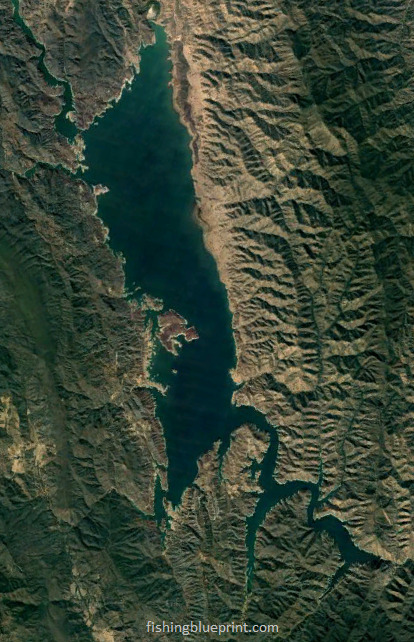
Lake Berryessa is a large lake that sits 77 miles away from San Francisco and 424 miles away from Los Angeles.
Overall it’s a popular lake being so close to San Francisco and Sacramento. In this post you’re going to be given the blueprint to fish this lake.
So what are the best tips for fishing Lake Berryessa? There are three important factors you must know if you want to know how to fish Lake Berryessa successfully. First, you need to know what kind of fish is in Lake Berryessa. Second, it’s important for you to know which part of the lake each species can be found. Lastly, knowing what are the best baits that work on Lake Berryessa is vital. However, tactics, baits, and locations will be different for each type of fish that you target. So let’s talk about the steps you need to take in order to give you the best chance of catching a fish on Lake Berryessa.
WARNING: There’s a lot of information about this subject you’ll probably want to come back to. No one expects you to remember all these tips. We know your time is precious, so we really tried to over-deliver in value for you. Additionally, we frequently update reports like this, so you’ll want to stay up to date with any changes or additional tips we include for you.
We found that the easiest way to save and bookmark this report so you can come back to it later is to share it on your favorite social media platform, especially if you use your phone to get important tips like the ones in this report here…
Click on your favorite social media buttons to remember this page now!
About Lake Berryessa
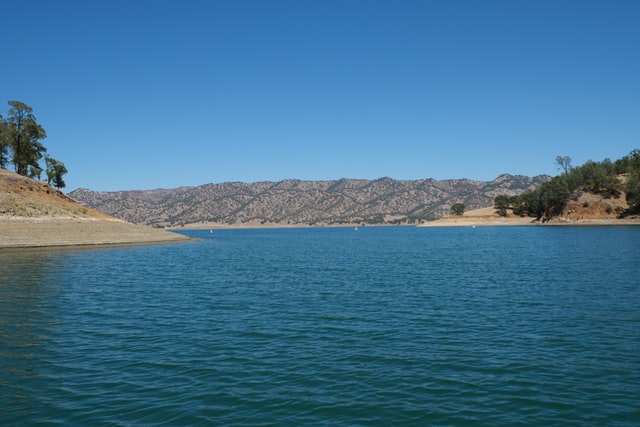
Lake Berryessa is a deep reservoir with the average depth ranging from 50-140 feet and a maximum depth of 275 feet when the lake is completely full. Lake Berryessa is 16 miles long and 3 miles across, Fishing Lake Berryessa gives anglers 165 miles of shoreline to fish over 20,700 acres.
This man-made reservoir plays a vital role in hydroelectricity, providing drinking water, and giving local areas crucial flood protection. Lake Berryessa gives locals and visitors the opportunity to test their luck in catching one of the many game species this lake has to offer.
Important Lake Warnings
Algae blooms may be present which may affect fishing, swimming, and water contact in general.
According to parks.ca.gov, “every one of California’s new laws requires boat operators to have a California Boating Card. The card is required for anyone under the age of 41 to operate a boat in California’s waters.”
If you are fishing and camping, fire bans may be in effect due to the ongoing drought conditions.
What Kind of Fish Are In Lake Berryessa
- Rainbow Trout
- Brown Trout
- Brook Trout
- Chinook/King Salmon
- Kokanee Salmon
- Largemouth Bass
- Smallmouth Bass
- Spotted Bass
- White and Black Crappie
- Bluegill and Sunfish
- Perch
- Catfish
Special Annual Events:
- Fishing Tournaments (year around)
- Poker Run
- Taco ‘Bout Boat Club
- Haunted Harbor
- Annual Hello Summer Kick Off Party
Lake Berryessa Fishing Tips & General Strategies

It can be a challenge to break down Lake Berryessa and decide to get started, but that’s why we’re helping you with this Lake Berryessa Fishing Report!
This lake is the spot for bass fishing and it’s not hard to see why. With a variety of fish such as catfish, Chinook and kokanee salmon, brown and rainbow trout, smallmouth and largemouth bass, spotted bass, and bluegill, you’re bound to have a reel good time… ok, ok, I promise that was my last Dad joke.
Let’s dive in and talk about some key aspects of fishing in Lake Berryessa.
Water Clarity:
One of the things that sets Lake Berryessa apart from other lakes is its crystal clear water. With an average visibility of 15 to 20 feet, you’ll be able to see everything beneath the surface. The water clarity is largely due to the lack of inflowing rivers, which keeps the water clear year-round. This feature makes it easy to spot potential fishing hotspots, and also makes it easier to identify what the fish are biting on.
Fishing Structures and Cover:
Lake Berryessa is home to a variety of fishing structures and covers. The most common structures include:
- Drop-offs: These are great spots for bass fishing because they provide a quick change in depth, which creates a perfect ambush point for bass waiting for their prey.
- Points: These structures are created by the jutting out of land into the lake, and they are a popular spot for bass fishing because they are a great ambush point for fish waiting for prey to swim by.
- Humps: These structures are underwater hills that rise from the lake’s bottom. They are great spots for bass fishing because they create a feeding zone for bass to wait and ambush prey as it swims by.
In terms of fishing covers, Lake Berryessa is full of them. The most common covers include:
- Brush piles: These are created when fishermen drop trees or bushes into the water. They provide great cover for bass and are a great spot for them to hide.
- Rocks: These are a common cover in Lake Berryessa and are great for bass fishing because they provide shelter and hiding spots for fish.
- Weed beds: These are a popular spot for bass fishing because they provide great cover and hiding spots for fish.
Spring Fishing Update On Lake Berryessa
During the spring months at Lake Berryessa in California, the air temperature typically ranges from the mid-50s to the mid-70s Fahrenheit.
Wind speed and direction can vary but are often light to moderate and predominantly out of the southwest.
The occasional breeze can make for some great topwater action, so keep your eyes on the weather report and pack your favorite poppers and buzzbaits.
As for water temperature, it can vary depending on the depth and location on the lake. In the spring, the surface temperature can range from the high 50s to low 60s Fahrenheit. The deeper water, especially near the dam, can be slightly cooler.
With the warming water temperatures, the bass will start moving shallower and become more active, so it’s a great time to hit the water and start targeting those hungry fish.
The spawning season for largemouth bass typically begins in March and lasts through June, with peak spawning activity occurring in May.
During this time, bass can be found in the shallower areas of the lake, near the shoreline and in coves, where they build nests on the bottom of the lake using rocks, gravel, and other materials.
Some of the best spots for bass fishing during spawning season include:
- the inlets of Putah Creek
- Pope Creek
- and north of the northern bridge
Trout and salmon also spawn in Lake Berryessa, typically during the fall season. The trout spawning season begins in October and lasts through November, while the salmon spawning season begins in November and lasts through December.
These fish can be found in the cooler, deeper waters of the lake during the spawning season, making trolling an effective method of catching them.
The water temperature plays a crucial role in the spawning process of fish. For bass to start spawning, the water temperature needs to be around 60°F.
In Lake Berryessa, the water temperature typically reaches this range from late February to early March, making this the ideal time to fish for bass.
Post Spawn Patterns
After spawning, bass and trout will move to deeper waters in search of cooler temperatures and food.
In Lake Berryessa, these fish can often be found near drop-offs, underwater ledges, and submerged structures, such as trees and boulders.
Some of the best locations for finding bass and trout after spawning include:
- Areas around Big Island
- Southern end of the lake near the dam
- Wragg Canyon Inlet
Summertime Fishing Is Heating Up on Lake Berryessa!
During the summer months of May, June, July, and August, Lake Berryessa experiences some hot and dry weather patterns.
The average air temperature can range from the mid-70s to the low 100s Fahrenheit, depending on the month.
In July and August, the weather is at its hottest, with temperatures frequently reaching triple digits… man, if there is no wind and the weather is brutal!
Wind speed can vary but tends to be calmer in the morning and pick up in the afternoon.
Berryessa water temps during the summer
The water temperature in Lake Berryessa during summer is warm and typically averages between 70 to 80 degrees.
But its important to know this temperature can significantly impact fishing presentations for bass and trout.
Bass tend to become more active (because their metabolism is crazy) and will move to deeper waters during the hottest parts of the day to stay cool… but they will eat all day long, even in the middle of the afternoon.
Trout will also tend to go deeper in the water column, where the cooler water temperatures can be found.
During the summer months, the primary forage for both bass and trout in Lake Berryessa is baitfish.
Threadfin shad and crawdads are some of the most common types of forage, and many anglers will use lures or bait that mimic these types of prey.
Some of the best techniques to catch trout and Kokanee on Lake Berryessa during the summer are:
- Trolling with downriggers and leadcore lines at various depths.
- Casting and retrieving lures such as spinners, spoons, and plugs.
- Fishing with bait, either on a bobber or a Carolina rig.
Here are 5 common baits to catch trout and kokanee in the summer:
- Berkley PowerBait in various colors and scents.
- Pautzke Balls O’ Fire salmon eggs.
- Needlefish spoons by Luhr-Jensen.
- Wedding rings by Mack’s Lure.
- Kastmaster lures by Acme Tackle.
Some specific location names where you can catch trout and Kokanee on Lake Berryessa during the summer are:
- The Narrows, a deep channel between Big Island and the mainland. In my opinion, this is one of the best areas.
- Skiers Cove, a popular spot for water sports where fish tend to congregate.
- The inlets of Putah Creek, Pope Creek, and Steel Canyon, where trout and Kokanee can be found in cooler water flowing in from tributaries.
When it comes to catching bass on Lake Berryessa during the summer, there are a few techniques and types of baits that tend to be most effective. Here are some tips to help you land some big bass:
Best Techniques:
- Fishing around structures: Look for structures like docks, trees, and brush piles where bass may be hiding out. Fish these areas thoroughly and try to cast your bait as close to the structure as possible.
- Drop shotting: This technique involves using a weight at the bottom of the line with a hook and bait above it. It is an effective way to target fish that are hiding in deeper water.
- Topwater fishing: During early morning and evening hours, bass may be feeding near the surface. Use topwater lures to imitate prey like frogs, insects, or small fish.
Fast Moving Baits:
- Spinnerbaits: A popular bait that imitates a baitfish, with blades that create vibration and flash to attract bass. Some popular brands include Strike King, Booyah, and War Eagle.
- Crankbaits: Designed to dive to a certain depth and create a wobbling action that mimics a swimming baitfish. Some popular brands include Rapala, Strike King, and Megabass.
- Chatterbaits: These lures have a unique blade that creates a vibration and flash in the water, imitating a fleeing baitfish. Some popular brands include Z-Man, Booyah, and Strike King.
- Swimbaits: These soft plastic lures imitate baitfish and are often fished with a weighted hook to create a swimming action. Some popular brands include Keitech, Huddleston Deluxe, and Basstrix.
- Jigs: Jigs are versatile baits that can be fished in a variety of ways, but a fast retrieve can imitate a fleeing baitfish. Some popular brands include Strike King, Booyah, and Biwaa.
Slow Presentation Baits:
- Worms: Soft plastic worms are a staple of bass fishing and can be fished with a variety of techniques. Some popular brands include Zoom, Roboworm, and Berkley.
- Tubes: These soft plastic baits imitate crawfish and can be fished on a jig head or Texas-rigged. Some popular brands include Strike King, Zoom, and Yamamoto.
- “Senkos”: These soft plastic stick baits commonly known as “Senkos” are versatile and can be fished a ton of different ways including weightless, wacky-rigged, or Texas-rigged. Some popular brands include Yum, Strike King, and of course Gary Yamamoto Custom Baits.
- Ned Rigs: These small finesse baits are often fished with a slow retrieve and can be effective when bass are finicky. Some popular brands include Z-Man, Strike King, and Roboworm.
- Creature Baits: These baits imitate crawfish or other creatures and can be fished slowly on a Texas-rig or jig. Some popular brands include Strike King, Berkley, and Zoom.
Specific Locations:
- Big Island: This island in the middle of the lake offers a variety of structures, including rocky points and submerged brush. Fishing around the edges of the island with Texas-rigged worms or jigs can be effective.
- Markley Cove: This is a popular area for bass fishing and has plenty of structures and cover to explore.
- The Narrows: This area between Markley Cove and Steele Canyon is known for its deep water and rocky structure, making it a good spot to target bass with deep diving crankbaits or jigs.
- Wragg Canyon: This narrow canyon on the east side of the lake. This area has deep water and rocky structures that can hold bass during the summer months. It offers shallow flats and deeper water, making it a good spot to try a variety of techniques. Fishing a drop shot or shaky head rig around rocky structure can be effective in this area.
Lake Berryessa is home to a variety of game fish besides bass, trout, and kokanee salmon. Here are some of the other types of game fish that can be caught in this lake, along with some tips on how to catch them:
- Catfish – To catch catfish in Lake Berryessa, anglers typically use stink bait or cut bait. Night fishing can be particularly productive, as catfish are more active during the cooler hours of the day. Popular locations for catfishing include the Putah Creek Inlet, Pope Creek Inlet, and north of the northern bridge.
- Bluegill – Bluegill can be caught using a variety of baits, including worms, crickets, and small jigs. They are often found in shallow water near vegetation or structure, and can be caught using a variety of techniques, including bobber fishing and fly fishing.
- Sunfish – Sunfish can also be caught using small jigs, worms, or crickets. They are often found near structure or submerged vegetation, and can be caught using a variety of techniques, including bobber fishing and fly fishing.
- Crappie – Crappie can be caught using small jigs or minnows, and are often found near submerged structure or vegetation. They can be caught using a variety of techniques, including vertical jigging and spider rigging.
- Striped Bass – Striped bass can be caught using live bait, such as shad or anchovies, or by trolling with lures such as swimbaits or crankbaits. They are often found near schools of baitfish, and can be caught at various depths depending on the time of day and water temperature.
But Where Are The Best Places To Fish At Lake Berryessa?
And in no particular order here is that list of the best fishing spots at Lake Berryessa.
DISCLAIMER: The material provided is for general information purposes only. It’s important to understand that any information provided in this article can change at any time. Any maps or graphics featured are not to be used as navigational aids. Fishing Blueprint will not be responsible for any personal injury or property damage from any misuse of the maps or graphics provided. It’s completely impossible to give you every single spot where you can potentially catch a fish. But, what this list does do is to give you a helping hand and narrow down to the most productive fishing spots.
Spanish Flat to Quarry Canyon
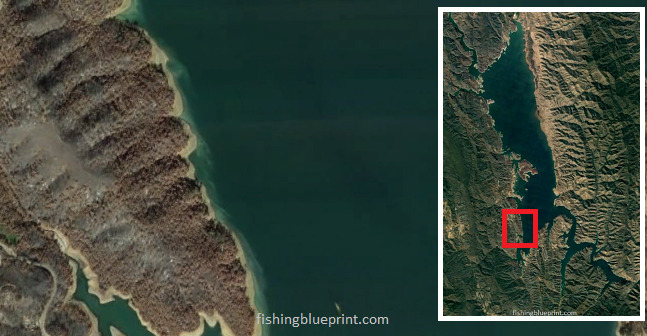
This spot is defined as an open flat with multiple submerged points, ledges, ridges, drop offs, and humps. This means you have many different structures you can target and fish.
The most productive areas will be where any channels or ditches are close to another type of structure (such as points, ledges, ridges, drop offs, or humps), or close to some form of cover (brush piles, laydowns, vertical standing timber, roadbeds, docks, bridge pilings, or any other form of artificial structure).
Submerged brush and deep weedbeds that can grow 10-15-feet deep in the back of the cuts and small pockets in this area.
Before trying to fish everything, be sure to take some time and scan these areas first with your fish finder to see if there are any bait or bass relating to that particular spot. If you see bait or bass in the spot then fish it.
Located: southwest lake
Structural features: points, ledges, ridges, drop offs, and humps
Best species to target: bass, crappie, sunfish, catfish
Most effective way to fish this spot: Boat, kayak, float tube, shoreline
Big Island and Small Island
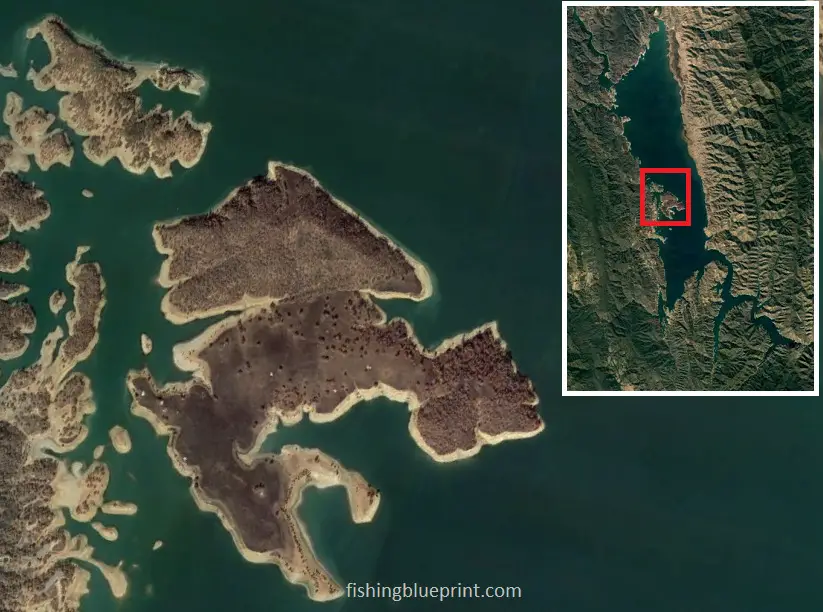
These two islands are located north of Spanish Flat.
The islands are characterized by the main river channel swing that runs into both islands.
Furthermore, you will also observe the creek channels that run between the islands and intersect with the main river channel.
Additionally, there are other smaller creek channels and ditches that intersect with one another that also have associated points, ledges, ridges, drop offs and humps that should be scanned for fish presence.
These two islands have plenty of submerged brush and deep weedbeds that can grow 10-15-feet deep in the back of the cuts and small pockets in this area.
In the spring, check for shallow spawning bass over gravel bars and in protected areas behind larger trees.
There are several hard bottom patches, small rock piles, and high spots on humps that should be checked for fish.
Lastly, there are several small drainage ditches that should be checked for fish as well.
Located: southwest lake
Structural features: points, ledges, ridges, drop offs, and humps
Best species to target: bass, crappie, sunfish, catfish
Most effective way to fish this spot: Boat, kayak, float tube, shoreline
Putah Creek (Mouth)
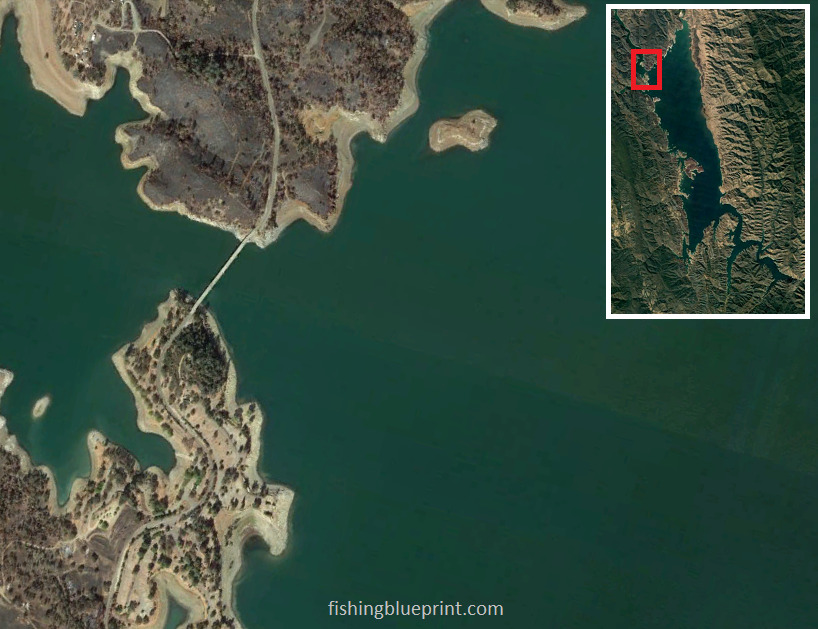
The mouth and surrounding areas of Putah Creek Bridge can be an incredible place to catch largemouth, smallmouth, and spotted bass, especially during the summer.
The secret to fishing this location is targeting the isolated rock piles and bedrock patches. Scanning the area with a fish finder to check for fish holding over the rocks is a must prior to fishing this area.
If the water level of the lake is really low, largemouth bass and crappies will hold in the submerged vertical timber.
Look Closely…

Located: southwest section of the lake
Structural features: Steep walled lake arm with several sharp creek channel bends, submerged brush and standing timber, large rock piles.
Best species to target: Bass, trout, crappie, catfish
Most effective way to fish this spot: Boat, kayak, float tube, shoreline
Putah Creek Arm
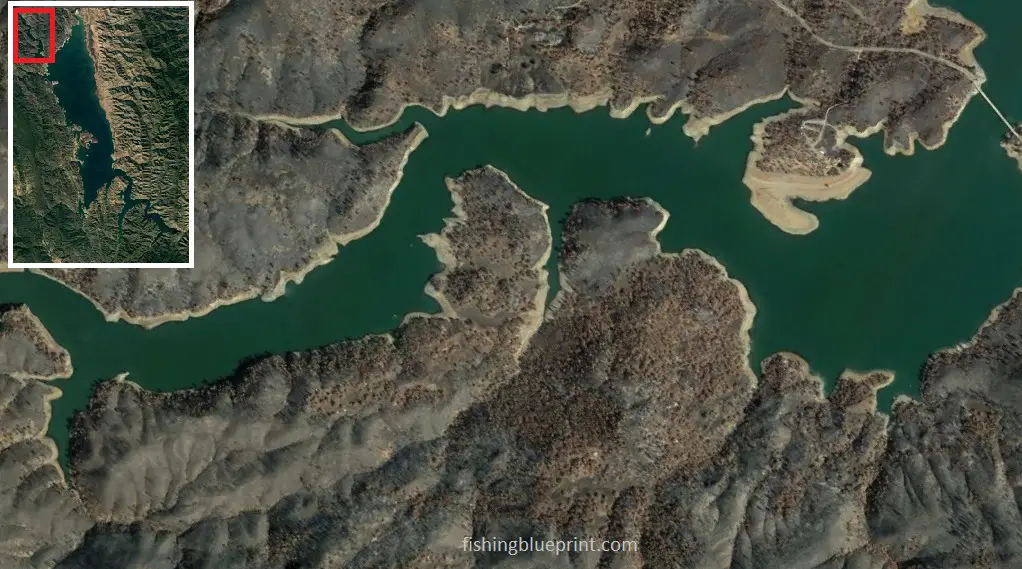
Located on the northwest section of the lake Putah Creek arm is a long winding channel that is excellent for largemouth bass, smallmouth bass, spotted bass, crappie and catfish, especially when the water is low.
Look Closely…

The channel holds a large amount of submerged brush and standing timber, along with submerged humps, isolated rock piles, and sharp channel swings.
Located: Northwest end of the lake
Structural features: Submerged brush and timber, submerged humps, channel swings
Best species to target: Largemouth bass, smallmouth bass, spotted bass, catfish, bluegill, and crappie
Most effective way to fish this spot: Boat
Eticurea Creek

Located on the northeast section of Lake Berryessa, the mouth is a relatively open area that can be fished for both largemouth, smallmouth bass, and spotted bass.
The area is lined with submerged weedbeds and floating grass mats.
This is a great spot if you want quiet solitude or want to avoid Barryessas strong winds or strong currents.
The mouth of the Eticurea Creek can be fished using fast moving lures such as chatterbaits, soft plastic swimbaits, swim jigs, or crankbaits.
Otherwise, anglers can venture up the river and use flipping baits or topwater lures around the submerged grass or slightly open water consider using drop shot rig, soft plastic swimbaits, swim jigs, crankbaits, or lipless crankbaits.
Believe it or not your best chance of success is to target this area in the hottest part of the day. Bass will tuck themselves deep in shadows thereby pinning themselves deep in the shadows.
Be sure to use a heavy fishing line when fishing thick vegetation.
Located: northeast end of lake
Structural features: Submerged weedbeds, floating mats, open bay
Best species to target: Largemouth bass, smallmouth bass, spotted bass, bluegill, catfish
Most effective way to fish this spot: Boat
The Vineyards
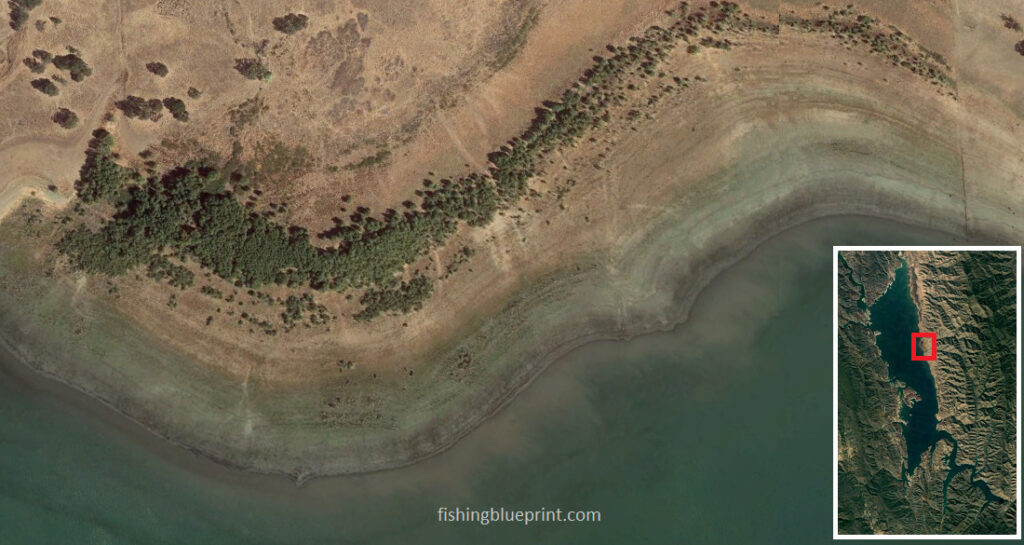
This is another “must fish” area in the spring. Submerged weeds, and vegetation mats support a healthy bass, bluegill, and even catfish population year round, but is best fished in the spring
The bank has several hundred yards of submerged brush of all sizes. Surprisingly, the area also has has several isolated hard bottom patches and rock piles.
However, recent reports reveal fisherman who target this area do best when the vegetation intersects with another form of structure or cover (drainage ditch or rock pile)
During the summertime, bass will chase shad in the shallows and then migrate deeper along the drainage ditches..
These open areas will frequently hold bass and anglers who like to fish with soft plastic lures tend to do pretty well.
Just remember, of you’re fishing grass that’s submerged fish over the tops with a topwater lure or frog lure, or you can fish the sumberged weedline with either a flipping bait or a reaction bait like a crankbait, spinnerbait, swim jig or a Chatterbait.
Located: west side of lake
Structural features: Submerged weedbeds, floating mats, open bay
Best species to target: Largemouth bass, smallmouth bass, spotted bass, bluegill, catfish
Most effective way to fish this spot: Boat
Ranch House (The Farmhouse)
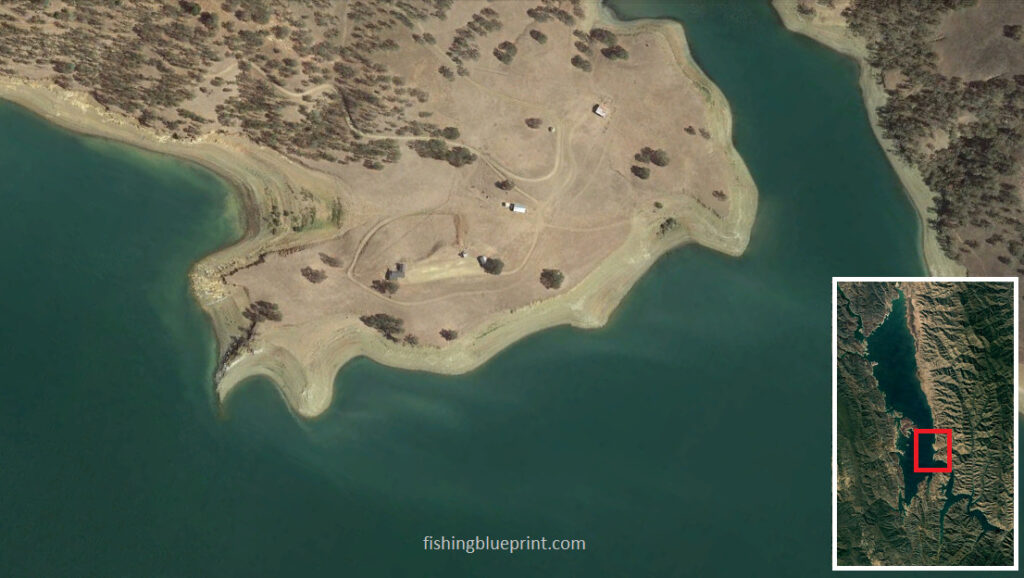
This main lake peninsula is sandwiched between two deep channels.
Even better, the south channel forms into a small cove with several ditches that drain into it. There are also several drop offs and ledges which makes it unique.
A really great feature about this area is the northern creek channel has multiple drop offs, boulders, rock piles associated with it.
Smallmouth and spotted bass really favor this location for its rocky structure and steep banks in 10-25-feet deep.
Largemouth bass can be caught in the rocks as well, but also in the cuts, pockets, and coves where submerged brush and weedbeds are present.
Located: west side of lake
Structural features: Rocky banks, submerged weedbeds, floating mats,
Best species to target: Largemouth bass, smallmouth bass, spotted bass, trout, bluegill, catfish
Most effective way to fish this spot: Boat
The Rockslide
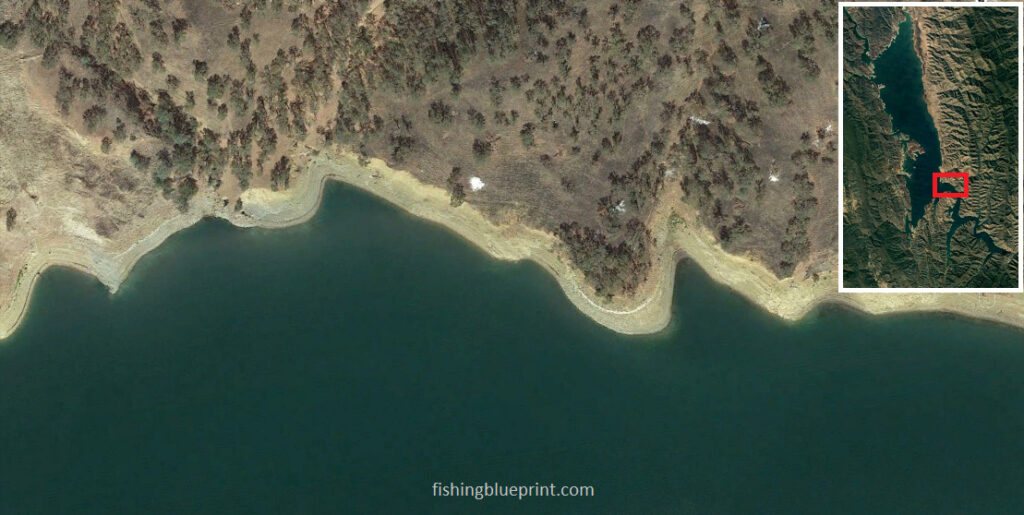
This section features a long rocky bank. The bank is characteristically very steep and made from large chunk rock to boulder-sized substrate.
Naturally, crawfish, bluegill, minnows, and shad seek shelter in this area.
Given this embankment’s large area, it’s best to focus your efforts on cuts, points, boulder piles, and transition areas from larger rock to smaller rock sizes.
Look Closely…
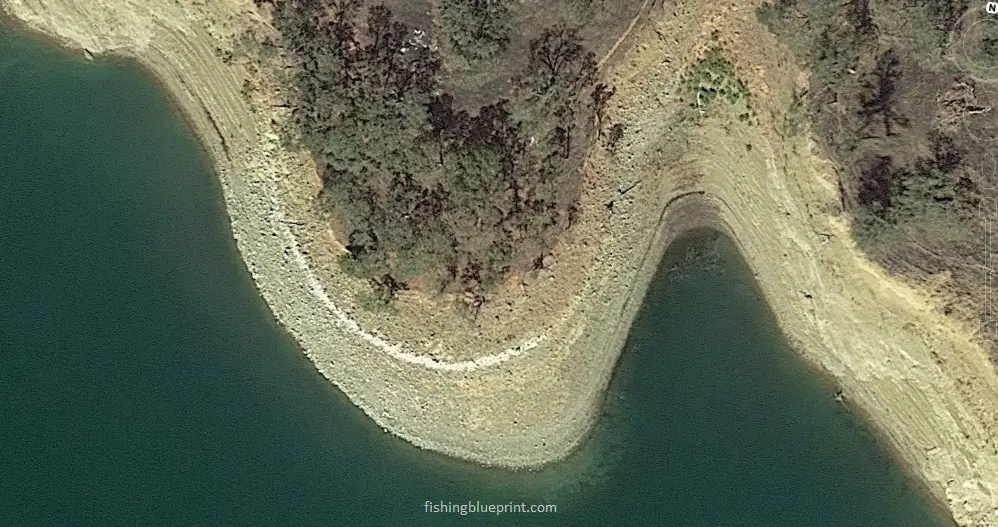
Located: Mid lake
Structural features: long rocky bank, boulder piles, transition areas
Best species to target: Smallmouth, spotted bass, trout
Most effective way to fish this spot: boat, kayak
The Narrows
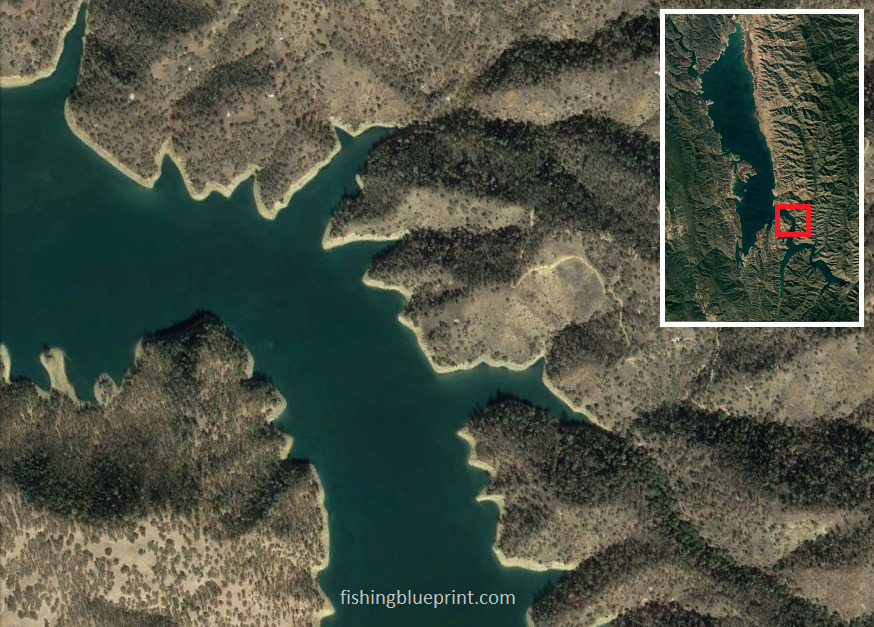
This section features a long narrow stretch of canyon. The banks are characteristically very steep and the water is deep.
The sides of the canyon banks consist of large chunk rock to boulder-size substrate.
This area attracts cold water loving fish like salmon, lake trout, rainbow trout, and even some brown trout.
Located: south section of the lake
Structural features: deep water main river channel, natural humps, bars and ridges
Best species to target: Salmon, trout
Most effective way to fish this spot: boat, kayak
The Dam

Fishing just outside the buoy line of the dam can catch you an abundance of salmon, lake trout, rainbow trout, and even some brown trout.
If the water is low, graph the cove just to the north of the dam and you can find bass and crappie suspended over submerged trees and rocky shelves.
This section of the lake can get very windy. And even with the best trolling motor the wind can quickly blow you off your spot which will significantly decrease your chances of catching a fish..
That is why we strongly suggest buying a quality drift sock. For those who don’t know, a drift sock is like a parachute for the water. If it’s breezy to windy, you need to slow your drift otherwise your lure will not be in the strike zone long enough to catch a fish.
By the way, we found a really good quality drift sock made by Mythik Outdoors, and best of all they’re sold on Amazon.com. Go here to learn more about drift socks and read the reviews from actual customers.
Located: southwest end of lake
Structural features: deep open water, submerged brush and timber on the north cove just outside the dam.
Best species to target: Coho salmon, lake trout, rainbow trout, largemouth bass, spotted bass,crappie
Most effective way to fish this spot: Boat, kayak, float tube
How To Catch Fish In Lake Berryessa?
Rainbow Trout
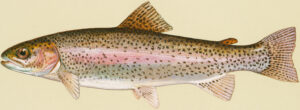 Spawn: March-May
Spawn: March-May
Food: insects and crustaceans.
California State Record: 27 lbs 0 oz. Caught 10/02/2005 in Lake Natoma.
Table Quality: Depending on the fishes diet, the meat can be white to orange-red in color. The meat is firm, flaky, and is considered excellent eating.
Angling techniques:
- Trolling with or without downriggers
- Fish attractor such as a flasher or a dodger – great when trolling.
- Trolling spoons such as a Krocodile spoon, Super Duper, Crippled Herring, Cast Champ, or Hus-Lure – simple, easy to use, can be trolled or cast-retrieved at any speed.
- Inline spinners such as the Bang-Tail and Shyster – gets a ton of bites.
- Minnow style baits such as the Luhr-Jensen Quick Fish and the Rapala BX minnow – known to hook up giant fish.
- Real or artificial corn – great because it will never spoil or mold over.
- Natural salmon eggs – it’s hard to beat natural salmon eggs at bait. When trout are eating salmon eggs, they’ll eat up a couple of jars in less than an hour!
- Artificial salmon eggs – great because they float off the bottom – ideal in rocky or grassy conditions.
- Real worms – such as meal worms or nightcrawlers.
- Artificial worms – great for trolling and will never die.
- Dry flies (floating flies) – The insects that land, float, or live on top of the water, which are represented by dry flies. Investing in a kit gives you a wide assortment of flies and a good selection of types and sizes allow you to quickly adjust to any situation.
- Wet flies (sinking flies) – Wet flies imitate insects that develop and inhabit below the water level before emerging and rising to the surface. Investing in a kit gives you a wide assortment of flies and a good selection of types and sizes allow you to quickly adjust to any situation.
- Woolly bugger flies – One of the most popular fly patterns ever is the Woolly Bugger. These mimic small fish, leeches, larvae, and worms. Investing in a kit gives you a wide assortment of flies and a good selection of types and sizes allow you to quickly adjust to any situation.
Steamer flies – They can also mimic larger animals found in streams and rivers, including crawfish, larger leeches, and smaller fish. Investing in a kit gives you a wide assortment of flies and a good selection of types and sizes allow you to quickly adjust to any situation.
- **The number one key to successful trout fishing, is to use light line (2 to 6 pound) and small hooks (10-14 sizes), and small sinkers
Chinook “King” Salmon
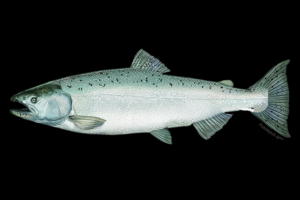 Spawn: September – December
Spawn: September – December
Food: Insects, small crustaceans, shad or other small fish.
California State Record: 65 lbs 4 oz. Caught 8/21/2002 in Crescent City.
Table Quality: Depending on the fishes diet, the meat can be white to orange-red in color. The meat is firm, flaky, and is considered excellent eating.
Angling techniques:
- Trolling with or without downriggers
- Fish attractor such as a flasher or a dodger – great when trolling.
- Trolling spoons such as a Krocodile spoon, Super Duper, Crippled Herring, Cast Champ, or Hus-Lure – simple, easy to use, can be trolled or cast-retrieved at any speed.
- Inline spinners such as the Bang-Tail and Shyster – gets a ton of bites.
- Minnow style baits such as the Luhr-Jensen Quick Fish and the Rapala BX minnow – known to hook up giant fish.
- Real or artificial corn – great because it will never spoil or mold over.
- Natural salmon eggs – it’s hard to beat natural salmon eggs when trout are eating salmon eggs, they’ll eat up jars of this stuff!
- Artificial salmon eggs – great because they float off the bottom – ideal in rocky or grassy conditions.
- Real worms – such as meal worms or nightcrawlers.
- Artificial worms – great for trolling and will never die.
- Dry flies (floating flies) – The insects that land, float, or live on top of the water, which are represented by dry flies.Investing in a kit gives you a wide assortment of flies and a good selection of types and sizes allow you to quickly adjust to any situation.
- Wet flies (sinking flies) – Wet flies imitate insects that develop and inhabit below the water level before emerging and rising to the surface. Investing in a kit gives you a wide assortment of flies and a good selection of types and sizes allow you to quickly adjust to any situation.
- Woolly bugger flies – One of the most popular fly patterns ever is the Woolly Bugger. These mimic small fish, leeches, larvae, and worms. Investing in a kit gives you a wide assortment of flies and a good selection of types and sizes allow you to quickly adjust to any situation.
Steamer flies – They can also mimic larger animals found in streams and rivers, including crawfish, larger leeches, and smaller fish. Investing in a kit gives you a wide assortment of flies and a good selection of types and sizes allow you to quickly adjust to any situation.
- **The number one key to successful trout fishing, is to use light line (2 to 6 pound) and small hooks (10-14 sizes), and small sinkers
Kokanee Salmon
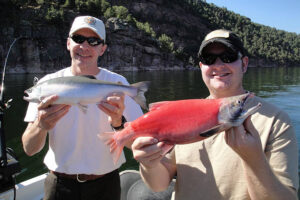 Spawn: September – December
Spawn: September – December
Food: Zooplanton, insects, small crustaceans, shad or other small fish.
California State Record: 5 lbs 2 oz. Caught 7/20/2013 in Lake Tahoe.
Table Quality: Depending on the fishes diet, the meat can be white to orange-red in color. The meat is firm, flaky, and is considered excellent eating.
Angling techniques:
- Trolling with or without downriggers
- Fish attractor such as a flasher or a dodger – great when trolling.
- Trolling spoons such as a Krocodile spoon, Super Duper, Crippled Herring, Cast Champ, or Hus-Lure – simple, easy to use, can be trolled or cast-retrieved at any speed.
- Inline spinners such as the Bang-Tail and Shyster – gets a ton of bites.
- Minnow style baits such as the Luhr-Jensen Quick Fish and the Rapala BX minnow – known to hook up giant fish.
- Real or artificial corn – great because it will never spoil or mold over.
- Natural salmon eggs – it’s hard to beat natural salmon eggs when trout are eating salmon eggs, they’ll eat up jars of this stuff!
- Artificial salmon eggs – great because they float off the bottom – ideal in rocky or grassy conditions.
- Real worms – such as meal worms or nightcrawlers.
- Artificial worms – great for trolling and will never die.
- Dry flies (floating flies) – The insects that land, float, or live on top of the water, which are represented by dry flies.Investing in a kit gives you a wide assortment of flies and a good selection of types and sizes allow you to quickly adjust to any situation.
- Wet flies (sinking flies) – Wet flies imitate insects that develop and inhabit below the water level before emerging and rising to the surface. Investing in a kit gives you a wide assortment of flies and a good selection of types and sizes allow you to quickly adjust to any situation.
- Woolly bugger flies – One of the most popular fly patterns ever is the Woolly Bugger. These mimic small fish, leeches, larvae, and worms. Investing in a kit gives you a wide assortment of flies and a good selection of types and sizes allow you to quickly adjust to any situation.
Steamer flies – They can also mimic larger animals found in streams and rivers, including crawfish, larger leeches, and smaller fish. Investing in a kit gives you a wide assortment of flies and a good selection of types and sizes allow you to quickly adjust to any situation.
- **The number one key to successful trout fishing, is to use light line (2 to 6 pound) and small hooks (10-14 sizes), and small sinkers
Largemouth Bass
General Largemouth Bass Details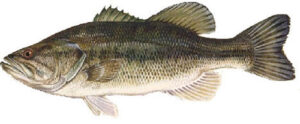
Read more: Beginner’s Guide To Bass Fishing Basics – Tips, Secrets & Things To Avoid
Food: Shad, minnows, small trout, small salmon, bluegill, perch, crayfish
California State Record: 21lbs 12 oz. Caught in 1991 in Castaic Lake at the main boat ramp.
Table Quality: Decent. Firm white meat.
Angling techniques:
Smallmouth Bass
 Smallmouth bass are a sibling species closely related to largemouth bass. They have a pretty brown/golden color and carry the nickname of “bronzeback”. There are a few physical features that make it different from the largemouth bass. Aside from being bronze in color, they will have gray-brown vertical bands and the most defining feature is the jaw does not extend past its eye.
Smallmouth bass are a sibling species closely related to largemouth bass. They have a pretty brown/golden color and carry the nickname of “bronzeback”. There are a few physical features that make it different from the largemouth bass. Aside from being bronze in color, they will have gray-brown vertical bands and the most defining feature is the jaw does not extend past its eye.
Overall, smallmouth bass are most likely going about half the size of largemouth bass. However, pound for pound, a smallmouth can be incredibly aggressive and will put up an amazing fight.
General Smallmouth Bass Details
Spawn: March-May
Food: fish, crustaceans.
California State Record: 9 lbs 13 oz. Caught 7/3/2007 in Pardee Reservoir.
Table Quality: Similar to a largemouth bass it’s firm, white, flaky, mild-tasting
Angling techniques:
- Finesse jigs
- Mojo Rig
- Neko Rig
- Small crankbaits
- Football Jigs
- Soft plastic swimbaits
- Jerkbaits
- Chatterbaits
- Swim jigs
- Hair jigs
- Underspin jigs
- Drop shot plastic worms
- Tubes
- Streamer flies.
- Live baits: minnows, hellgrammites, and crayfish
White and Black Crappie
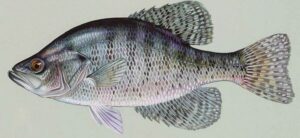
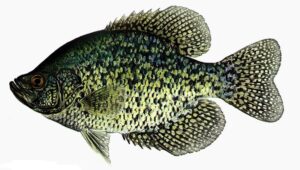 Spawn: April – mid-June
Spawn: April – mid-June
Food: Larvae, small fish, and crustaceans. Threadfin shad and minnows make up their main diet.
California State Record:
- White crappie: 4 lbs 8 oz. Caught 4/26/1971 in Clear Lake using minnows.
- Black crappie: 4 lbs 8 oz. Caught 2/17/2021 in Clear Lake using minnows.
Table Quality: The meat is excellent. It’s firm, flaky and white.
Angling techniques:
- Live minnows under bobbers
- Crappie jigs
- Crappie tubes
- Silver spoons
- Spinners
Catfish
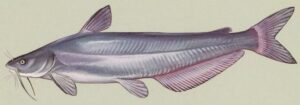 Spawn: March-June
Spawn: March-June
Food: Carp, bluegill
California State Record:
Blue catfish – 72 lbs 14 oz. Caught 4/22/2003 in Colorado River (Riverside).
Bullhead catfish – 4 lbs 8 oz. Caught 10/7/1993 in Trinity Lake.
Channel catfish – 53 lbs 8 oz. Caught 9/22/2008 in San Joaquin River.
White catfish – 22 lbs 0 oz. Caught 3/21/1994 in Land Park pond (Sacramento).
Table Quality: Soft white meat. In the summer the meat will taste muddy.
Angling techniques:
- chicken liver
- hotdogs
- stink bait
- small live bluegill, sunfish, or perch
- Frozen cut bait; anchovies, mackerel or sardines.
Bluegill or Sunfish
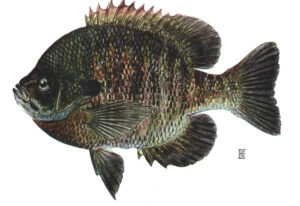 General Bluegill/ Sunfish Details
General Bluegill/ Sunfish Details
Spawn: April and May
Food: Small fish and insects
California State Record:
Bluegill – 3 lbs 14 oz. Caught 6/22/2008 in Rancho Murieta Reservoir.
Sunfish (red ear) – 5 lbs 3 oz. 6/27/1994 in Folsom South Canal (Sacramento)
Table Quality: Firm, white meat
Angling techniques:
- Worms
- Dough balls
- Slim Jim sausages pieces on a small hook (not lying… it really works)
- Small spinners
- Trout flies
Boat Ramps at Lake Berryessa
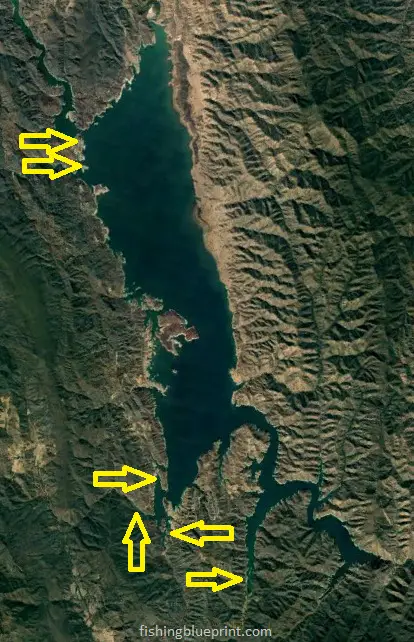
Pleasure Cove Marina & Boat Launch Ramp
- Address: 6100 CA-128, Napa, CA 94558
- Phone number: (707) 966-9600
- Lanes: 4
- Restrooms: Yes
- Showers: Yes
- Gas: Yes
- Groceries/snacks available: Yes
- Electric: No
- Camping nearby: Yes
Capell Cove Boat Launch Ramp
- Address: 1547 Knoxville Rd, Napa, CA 94558
- Website: usbr.gov
- Phone number: (707) 966-2111
- Lanes: 4
- Restrooms: Yes
- Showers: no
- Gas: no
- Groceries/snacks available: no
- Electric: No
- Camping nearby: No
Markley Cove Boat Launch Ramp
- Address: 7521 CA-128, Napa, CA 94558
- Phone number: (707) 966-2134
- Lanes: 2
- Restrooms: Yes
- Showers: no
- Gas: Yes
- Groceries/snacks available: Yes
- Electric: No
- Camping nearby: Yes
Putah Canyon Campground Boat Launch Ramp
- Address: 7521 CA-128, Napa, CA 94558
- Phone number: (707) 966-9051
- Lanes: 3, must be a registered camper to use
- Restrooms: Yes
- Showers: no
- Gas: no
- Groceries/snacks available: Yes
- Electric: No
- Camping nearby: Yes
Steele Canyon Boat Launch Ramp
- 1605 Steele Canyon Rd, Napa, CA 94558
- Phone number: (707) 966-9179
- Lanes: 3
- Restrooms: Yes
- Showers: no
- Gas: no
- Groceries/snacks available: no
- Electric: no
- Camping nearby: Yes
Marinas at Lake Berryessa
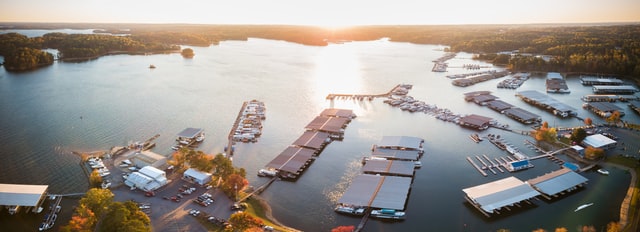
Pleasure Cove Marina
- Address: 6100 CA-128, Napa, CA 94558
- Phone number: (707) 966-9600
- Boat launch ramps on site: Yes
- Restrooms: Yes
- Showers: Yes
- Gas: Yes
- Groceries/snacks available: Yes
- Electric: No
- Camping nearby: Yes
Tackle Shops Near Lake Berryessa
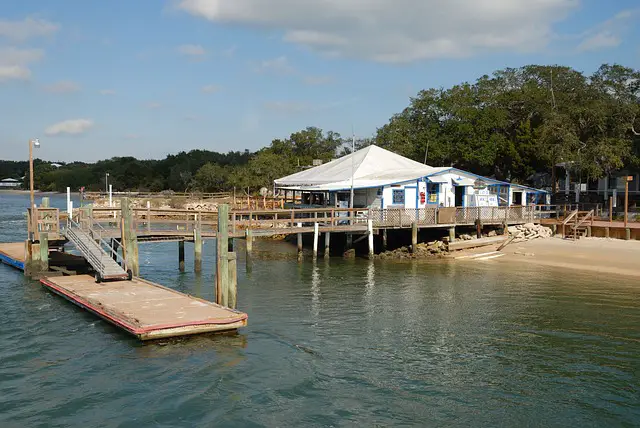
Berryessa Sporting Goods
- 115 E Grant Ave, Winters, CA 95694
- (530) 795-1278
New Romeo’s Bait & Tackle Shop
- 8120 Freeport Blvd, Sacramento, CA 95832
- (916) 665-1788
Sportsman’s Warehouse
- 5195 Redwood Dr, Rohnert Park, CA 94928
- (707) 585-1500
Outdoor Pro Shop
- 412 Houser St, Cotati, CA 94931
- (707) 588-8033
Other California Related Fishing Articles
- Bass Lake Fishing Report
- Clear Lake Fishing Report
- Castaic Lake Fishing Report
- California Delta Fishing Report
- Diamond Valley Lake Fishing Report
- Don Pedro Reservoir Fishing Report
- Eagle Lake Fishing Report
- El Capitan Reservoir Fishing Report
- Lake Berryessa Fishing Report
- Big Bear Lake Fishing Report
- Folsom Lake Fishing Report
- Irvine Lake Fishing Report
- Lake Almanor Fishing Report
- Lake Camanche Fishing Report
- Lake Isabella Fishing Report
- Lake Havasu Fishing Report
- Lake McClure Fishing Report
- Lake Oroville Fishing Report
- Lake Perris Fishing Report
- Lake Piru Fishing Report
- Lake Skinner Fishing Report
- Lake Tahoe Fishing Report
- Los Banos Reservoir Fishing Report
- New Hogan Lake Fishing Report
- New Melones Lake Fishing Report
- O’Neill Forebay Fishing Report
- Pardee Lake Fishing Report
- Pyramid Lake Fishing Report
- San Luis Reservoir Fishing Report
- San Vicente Reservoir Fishing Report
- Shasta Lake Fishing Report
- Silverwood Lake Fishing Report
- Trinity Lake Fishing Report
- Whiskeytown Lake Fishing Report
More articles just for you...
Funny Fishing Rules, Laws, and Regulations 2025
Crazy Fishing Laws That Will Blow Your Mind! #7 is INSANE! Strange Fishing Regulations and Laws As silly as hook and rod limits may seem,
EXPOSED! How To Use A Spinnerbait The Right Way for 2025
Are You Wondering How To Use A Spinnerbait? Or How To Work A Spinnerbait Over Grass, Logs, or Points? Well, All These Questions Are Answered
EXPOSED! Best Crankbait Colors for 2025 [Which to Buy & Avoid]
What color crankbait to use? Crankbait Color Chart I just love going into a Bass Pro Shops store and just staring at all the walls
Best Underwater Dock Lights For Fishing – 2025 Buyers Guide
Night Dock Light Fishing For Beginners Dear fellow angler, Does this sound like you? You’re someone who loves fishing but just wants to escape the
15 Best Deep Diving Crankbaits [2025 Buyers Guide – Which to Buy & Avoid]
A Complete Buyer’s Blueprint On The Best Deep Diving Crankbaits for Bass, Walleye, or Striped Bass On The Market Today Fishing deep diving crankbaits can

